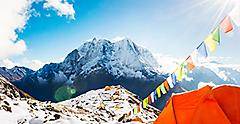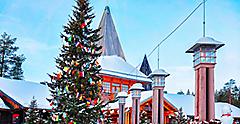There are few experiences more wondrous than standing under a dark sky illuminated solely by stars. The stars we see today are the same that have led voyagers across oceans, inspired myths and legends as well as spurred scientists' journeys into space.
Feeling inspired to take a vacation for seeing stars? Astrotourism relates to traveling somewhere in world deliberately for stargazing. If you're in search of the best astrotourism places to see stars without city lights dimming their luster, then these stargazing vacation destinations are all shining contenders.
Witness The Lunar Landscape
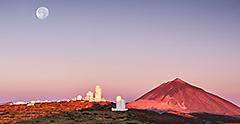

If you've spent most of your nights near big cities, you might be wondering — can you see the Milky Way from Earth? The answer is yes, if you're in the right spot.
The Milky Way is a grand spiral galaxy that looks like a cream-colored arch of dense stars across the sky. While almost all cultures developed legends about the meaning and origins of Earth's galaxy, the Greeks and Romans saw the streak of stars as a river of milk, which is how it got its name.
One of the best places to admire the Milky Way is at the Atacama Desert in Chile. The Milky Way rises and sets in Earth's Southern Hemisphere, appearing overhead in destinations like Chile.
The Atacama Desert is a hub for nearly half of the world's major astronomy studies thanks to its high elevation, low humidity and remote location far from any sources of light pollution. By day, the desert is striking, with rust-colored mountains and buttes and plains of sand that stretch for miles. Once night falls, the landscape looks like it's stuck in a snow globe of stars.
Locating A Stargazer's Dream Destination

The Island of Hawai'i (or "Big Island," south of Maui) is an astrotourist's dream destination, with dark skies stretching over the lava fields. The sacred summit of Mauna Kea is home to some of the world's most powerful telescopes, and there are plenty of stars to be seen with the naked eye from the visitor center. You can look at the same constellations Polynesian seafarers once used to navigate across the Pacific Ocean from the Marquesas Islands.
Skies above Mauna Kea are so clear due to the lack of air and light pollution, as well as the elevation. From seabed to summit, Mauna Kea eclipses Mount Everest, but it is only around half of Everest's height when measured from sea level.
Even on a cloudy night, Hawai'i is one of the most beautiful places in the world. Depending on what's brewing beneath the Earth's crust, you might be able to see the amber glow from a lava lake at Volcanoes National Park. The park sometimes has volcanic fog, or "vog" casting a veil over some of the stars, but it's still a stunning sight to behold.
Head to the waters of Kona and embark on a guided night swim with manta rays, who swim with mouths agape under the glow of an artificial light in search of plankton. The mantas often look like alien acrobats. This sight, coupled with the glowing moon overhead, will linger with you long after you leave Hawai'i.

If you're on an astrotourism journey, you will likely end up in New Zealand. Aoraki Mackenzie International Dark Sky Reserve on New Zealand's South Island is the largest dark sky reserve south of the equator, designed for astronomical travel. There are regulations around the region to prevent light pollution, guaranteeing dark skies for those who visit. The reserve encompasses Aoraki/Mount Cook National Park and stretches to the Mackenzie basin — so there's no shortage of finding a spot to observe the cosmos all to yourself.
Studying the stars was how Māori navigated their vessels from the islands of Tahiti to New Zealand, and this reserve helps to preserve the country's heritage. Māori legend explains how the creation story can be seen in the stars, in a constellation called Matariki (also known as the Pleiades).
Tour guides host informative and entertaining stargazing tours. You can catch tours at the Mount John Observatory, as well as workshops for astrophotographers and adventurers. There are also tours that include peeking through telescopes followed by a relaxing soak in the hot springs of Tekapo.
Gaze Upon A Natural Light Show
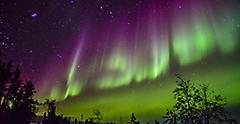
If you want a chance to see the aurora borealis, also known as the northern lights, venture north to Alaska. During the aurora borealis, the sky dances and flickers with colors that span electric shades of green and yellow, with hues of red and violet swirling around. The mesmerizing scene is caused by solar winds and is only found near the Arctic circle. (The Antarctic circle hosts its own light show called aurora australis.) In Alaska, you can admire the light show above as you soak in a hot spring, dogsled over snowy plains or cast a line in an ice fishing hole.
Valerie Stimac — founder of SpaceTourismGuide.com and author of "Dark Skies: A Practical Guide to Astrotourism" — recommends Alaska as one of the best places to stargaze in the world, thanks to its long nights and low levels of light pollution. She advises waiting until the nights are longer to head to Fairbanks. "By early to mid-September, your odds of seeing the aurora are greatly improved by more darkness each day and an ideal position for the solar activity that causes the aurora," she says. "While it is possible to see the northern lights as far south as Alaska's Inside Passage, your chances get better the further north you go."

For more thrills in the sky, head to Iceland. Iceland is a land of natural wonders. With its powder blue geothermal pools, volcanic craters, crashing cascades and sparkling glaciers, this is a destination that caters to curiosity. During wintertime, the skies are often alight with the dancing display of aurora borealis. But if the northern lights are not around, it's also a prime place to search for constellations, planets, meteors and nebulae. Stargazing tours depart from Reykjavík nightly, guiding eyes upward through powerful telescopes.
In the city itself, you'll have a chance to visit Perlan, a museum with a rotating glass dome with an observation platform. There's also an interactive planetarium film about the aurora borealis that reveals what causes this natural phenomenon, and the many legends surrounding it.
Where Stars Meet Nature
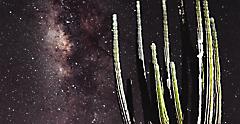
Mexico's Baja Peninsula is not quite populated, with only a few towns strewn along its coastline. The sky clarity (the Baja Peninsula sees 300 days of sunshine per year) and lack of air pollution make this region a spectacular scene come nighttime. Stargaze near any of the main hubs of the Baja Peninsula, like Cabo San Lucas or La Paz, by putting a little distance between you and the city. During summertime, you may spot the planets Mars, Jupiter and Saturn, as well a wide range of constellations.
The town of Cabo San Lucas runs boat excursions out to the open ocean after dark. On a calm night with no wind, the stars reflect onto the water, and it's nearly impossible to distinguish the sea and the sky. For a fully astronautical feel, venture out on a night scuba dive, where you'll be neutrally buoyant like an astronaut in space. The waters off the Baja Peninsula are often alive with bioluminescent plankton that glow and swirl in the water like miniature galaxies. Gaze up when you emerge from your dive for an immersive starry experience.

The remote wilderness of Nova Scotia is home to the Acadian Skies and Mi'kmaq Lands Starlight Reserve, backed by the UNESCO Starlight Foundation, where dark skies are a protected asset of the community. The region regularly hosts astronomy workshops and stargazing festivals to welcome vacationing astrotourists under its skies. If you're interested in astrology, this is a great place to search for constellations. You'll be following a long line of indigenous people who used celestial clues to predict terrestrial activity.
Under sunlight, the region's enormous pine, cedar and spruce trees cloak the landscape. Hiking trails, lakes, inlets and sandy beaches make it one of Canada's most relaxing destinations, while the lack of artificial light draws all kinds of wildlife. Come nightfall, the sweet and refreshing scent of the trees lingers in the air, reminding you that you're still on planet Earth as you gaze at the cosmos above.
Tips For Stargazing Around The World
1. New Moon Is The Best Moon
2. Avoid Bright Lights
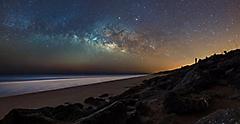
Spectacular stargazing destinations tend to be in the most remote places, far from the light pollution and smog that comes with big cities and suburbs. If skies are clear, venturing to places less traveled usually reveals smatterings of bright stars. NASA recommends finding higher elevations to stargaze from to place yourself above haze and fog that could get in the way of the stars.
Once you've found a prime place to peer up, Stimac recommends not rushing your star seeking experience. Allow "15 to 20 minutes for your eyes to adjust, so you can see more stars." That includes any phenomena like the aurora. Turn off your flashlight and avoid checking your phone before stargazing to help your eyes acclimate to the darkness.
3. Take Advantage Of A Stargazing App
4. Make The Most Of Your Time
Get Royal Deals, Sign Up Today

Getting There
Explore Our Most Affordable Itineraries
Enjoy peering up at the universe as you cruise from one star-rich night sky destination to another onboard the Ultimate World Cruise.




